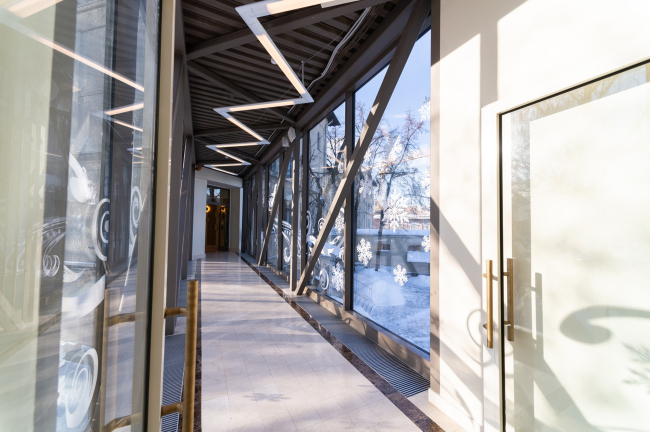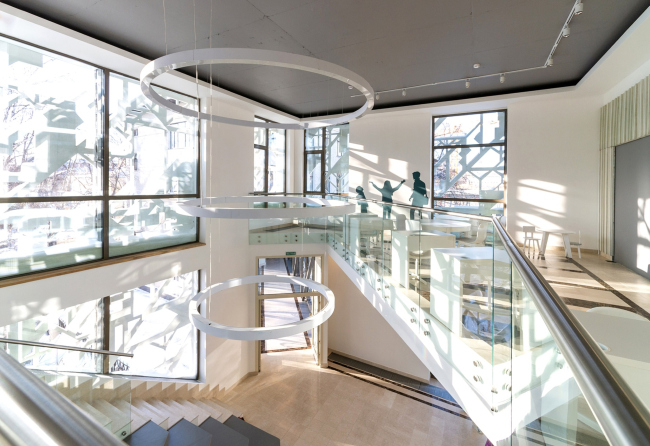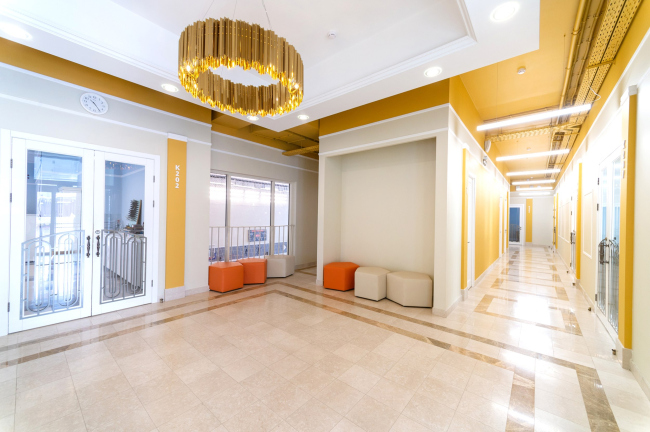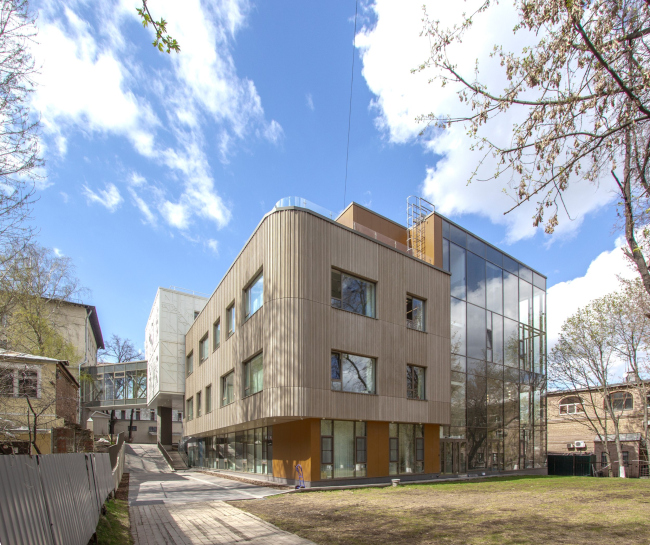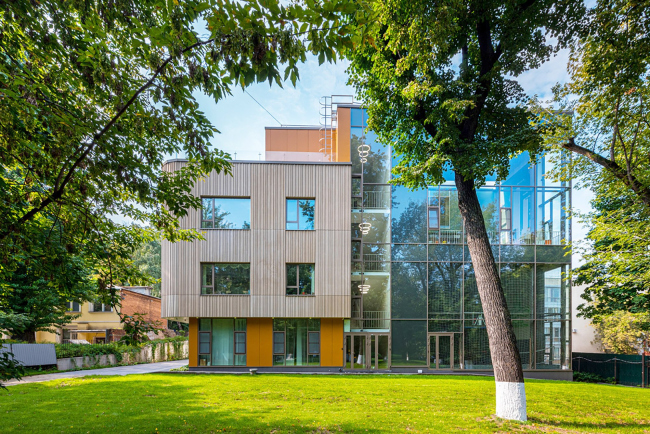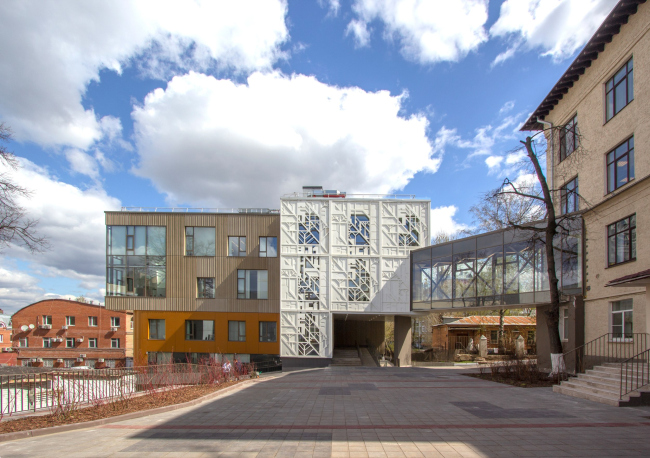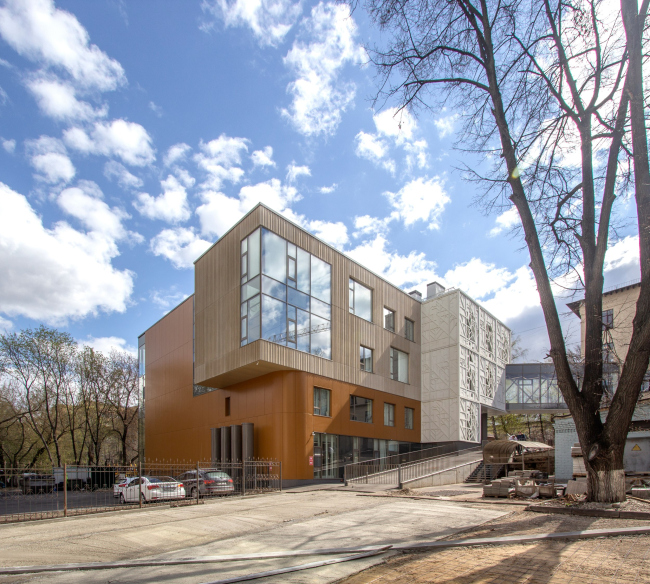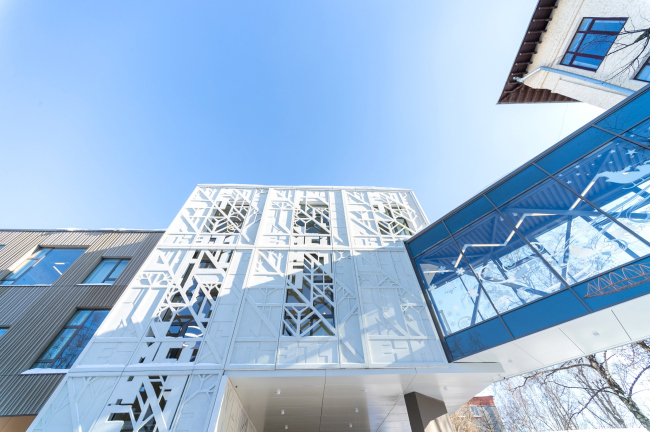|
Published on Archi.ru (https://archi.ru) |
|
| 13.10.2021 | |
|
The Town in the Snuff-box |
|
|
Julia Tarabarina |
|
| Architect: | |
| Andrey Asadov | |
| Studio: | |
| ASADOV architects | |
|
The new academic building of Cooperation School in Moscow’s Taganka, designed and built by ASADOV Architects, is a compact volume, at the same time filled with functions and impressions. It easily combines classrooms, a theater, a cafeteria, a gym, and a double-height atrium with an open library and an exit to the terrace – virtually everything that you expect to see in a modern school. “” has been in existence since 1990; since 1993 it has been functioning as a private one. Its main building – a school building four stories high, constructed in 1936 – is situated on Alexander Solzhenitsyn Street, directly behind an office and shopping center that is being built right now by the project of Aleksey Ginzburg, across the Garden Ring opposite the Taganka Theater, and next to a fitness center built in 2007-2009 by a SPEECH project – and the school students are using the fitness center’s swimming pool. In a word, the architectural context around the school, located next to one of Moscow’s central squares, is quite decent, and one can only be happy about the fact that, looking to expand its premises, the school commissioned the project of its new building to ASADOV Architects – but then again, a few years ago, in 2016, this architectural company already completed the construction of a kindergarten, belonging to Cooperation School, in the Maly Poluyaroslavsky Alley, not far away from the Kurskaya metro station. The location plan. The academic building of the “Cooperation School” on TagankaCopyright: © ASADOV ArchitectsThe 1936 school building is located deep in the block between two streets: Alexander Solzhenitsyn and Bolshoy Drovyanoy Alley, with its side wall facing the Garden Ring. The other side wall (the eastern one) gives a start to the school yard – in this sense, the school has been lucky again because not always the school students get such a big schoolyard in the center of the city. The new building is located near the north corner of the old building, at the beginning of the yard; the architects were also able to preserve much of the green space. In addition, Taganka is widely known for its hilly terrain – there are staircases and slopes all around – and the new building is also partially “buried” in the slope, the height difference being about 7 meters, so in its northern part it has four floors, and in the southern part three. There are several ramps on the western corner, which use the height drop, and entrances and exits at different levels. The main entrance to the new building, however, is made in the hanging glass passage situated on the level of the 2nd floor of the old building. The academic building of the “Cooperation School” on TagankaCopyright: Photograph: provided by ASADOV ArchitectsThe passage connects the corners of the two buildings diagonally and leads the students into a small double-height atrium, very well lit, since its right part (counting from the entrance) faces southeast. As is known, the atrium is one of the key parts of modern school buildings: it serves both for relaxation and for communication /socialization of the students. The atrium also noticeably lifts your spirits when you enter – thanks to the sun glares and a significant height, it just makes you take a deep breath and somehow take a look around. The academic building of the “Cooperation School” on TagankaCopyright: Photograph: provided by ASADOV ArchitectsThe atrium is not exactly large but it nevertheless has enough room for four steps of the amphitheater, a string of ring lights, enhancing the height of the space, and a balcony with a few bookcases of the open library. The second tier running along the glass façade is accessed by a staircase, which also leads to the terrace balcony that stretches along the east façade above the school yard. It is fenced by an impost-less glass barrier, and it will be used for both walks and school events. The connection of the atrium with the external space, in addition to the exit to the balcony and stained glass windows, is also marked through the use of fiberglass concrete slabs with relief vertical stripes similar to the ones on the façade – they decorate the western wall in the interior, emphasizing that a volume is “docked” on this side, the external texture of which is exactly the same.  The atrium. The academic building of the “Cooperation School” on TagankaCopyright: Photograph: provided by ASADOV Architects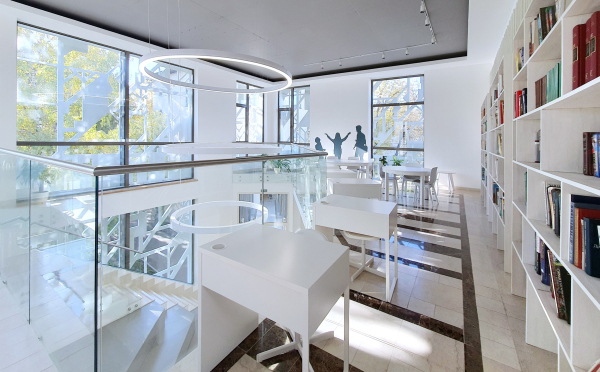 The atrium. The academic building of the “Cooperation School” on TagankaCopyright: Photograph: Archi.ru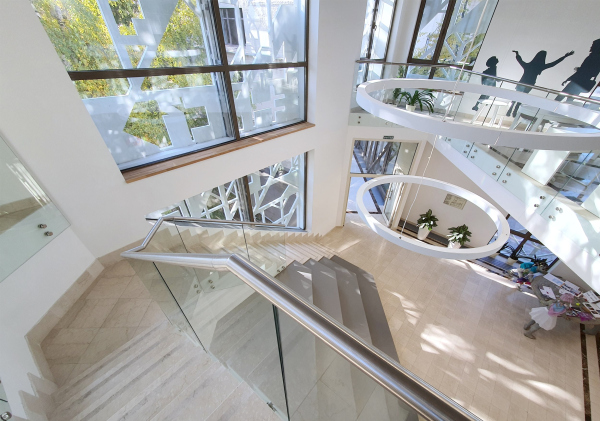 The atrium. The academic building of the “Cooperation School” on TagankaCopyright: Photograph: Archi.ru The academic building of the “Cooperation School” on TagankaCopyright: Photograph: provided by ASADOV ArchitectsSince the building faces the entrance at an angle, the paths diverge from the atrium in a fan-like manner; to the right, there is a corridor that runs along the doors of small classrooms, to the left, there are laboratory rooms. The ceilings of the corridors are quite high; the exposed ventilation structures are painted in their own color for each floor, which, like the general difference in tone in the interiors, facilitates intuitive navigation. The academic building of the “Cooperation School” on TagankaCopyright: Photograph: provided by ASADOV ArchitectsThe most interesting of the specialized classrooms is the biology study with a tall double-height space, a stained glass window, a skylight, and yet another internal window that allows you to look down from the school space into the study from above. Its white walls are decorated with volumetric semblances of DNA spirals, and inside the school is planning, using a well-lit double-height space, to make a winter garden (some of the plants in the tubs are already there). 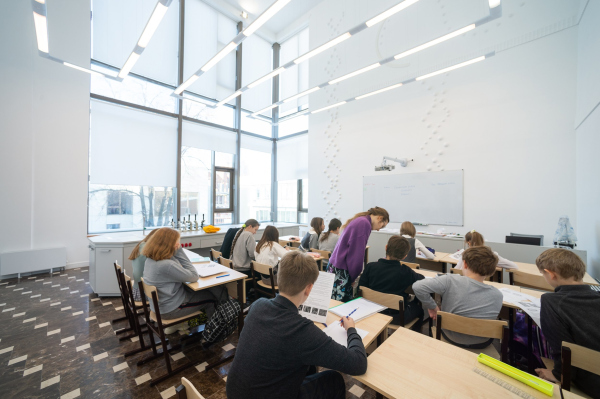 The biology study. The academic building of the “Cooperation School” on TagankaCopyright: Photograph: provided by ASADOV Architects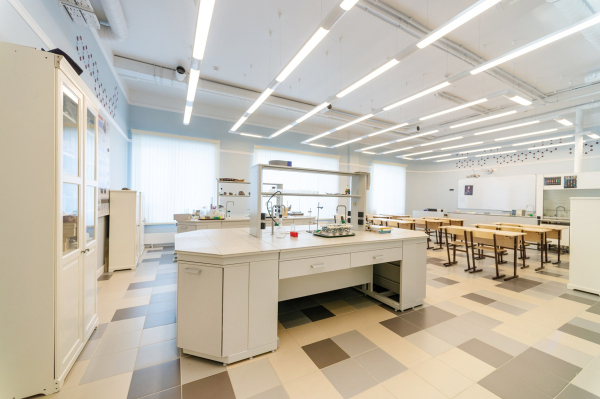 The physics study. The academic building of the “Cooperation School” on TagankaCopyright: Photograph: provided by ASADOV Architects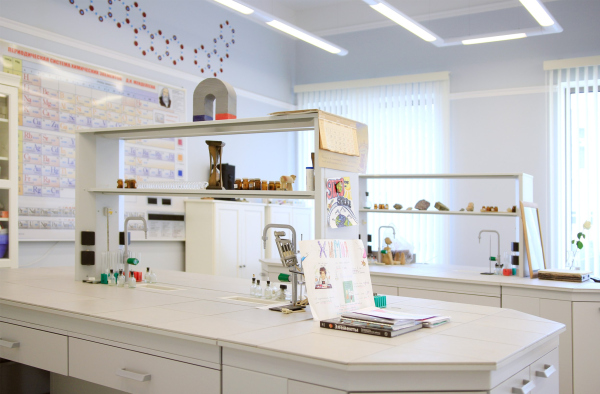 The chemistry study. The academic building of the “Cooperation School” on TagankaCopyright: Photograph: Archi.ru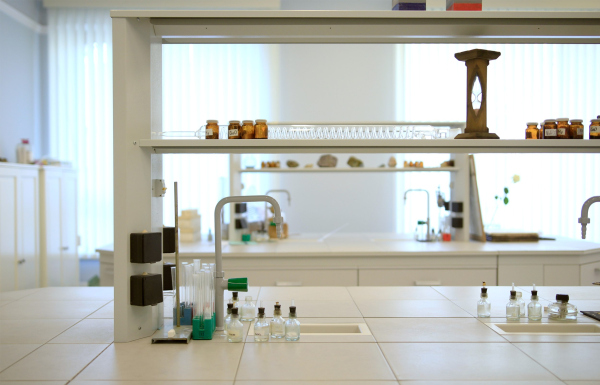 The chemistry study. The academic building of the “Cooperation School” on TagankaCopyright: Photograph: Archi.ru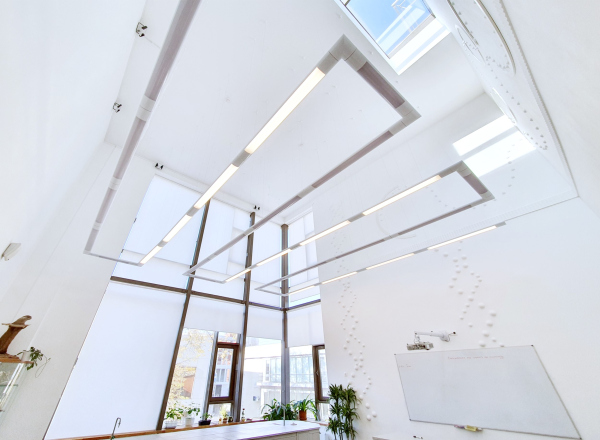 The biology study. The academic building of the “Cooperation School” on TagankaCopyright: Photograph: Archi.ruThe northern part of the building includes: (at the bottom) a tall gym with a balcony, and (at the top) a canteen with a thin slit of the skylight, and a small theater hall above its western part. The eastern walls of both the gym and cafeteria are made of glass and overlook the garden. The theater hall is darkened by curtains, but when the curtains are open, you can look from it to the east into the canteen, and to the north towards the Bolshoy Drovyanoy Lane – it should be noted that there are generally quite a lot of opportunities to look from one space to another, starting from the glass doors of all the classrooms and ending with stained glass windows of all large rooms and several skylights.  The academic building of the “Cooperation School” on TagankaCopyright: Photograph: provided by ASADOV Architects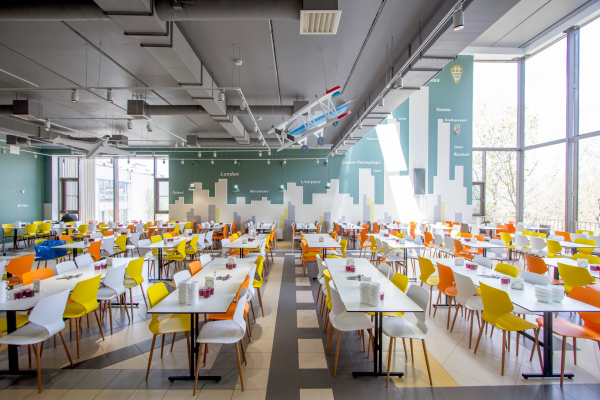 The academic building of the “Cooperation School” on TagankaCopyright: Photograph: provided by ASADOV Architects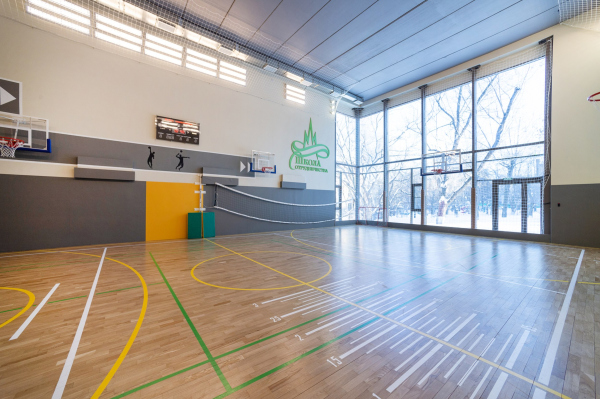 The academic building of the “Cooperation School” on TagankaCopyright: Photograph: provided by ASADOV ArchitectsAll these functions are “packed” in a compact volume, which, as we remember, is inscribed into a slope. This volume, however, is far from simple; it is livened up by two, not excessively big, but rather expressive cantilevers and designed on the outside as composed of three parts made of different materials. The simplest one of them is made up of golden-red aluminum panels in its bottom part, another, the most volumetric one, is made of striped fiberglass concrete: it appears on the northwest corner, where the biology study stands out in a two-level cantilever, as well as on the southern and eastern facades, also in a cantilever but with a rounded corner, where it marks the main mass of the small to midsize classrooms, and neighbors on the glass wall of the gym and the cafeteria. The academic building of the “Cooperation School” on TagankaCopyright: Photograph: provided by ASADOV ArchitectsThe academic building of the “Cooperation School” on TagankaCopyright: Photograph: provided by ASADOV ArchitectsThe most spectacular part of the facade – a kind of “lace” – forms the entrance corner and atrium, from which we began our story, emphasizing, already from the outside, the entrance from the building. Fiberglass is also used here, not grayish-brown, as in the main part, but bright-white, with an openwork pattern, see-through in the windows, and with relief on the outside. The pattern combines stylized diagonal geometry of tree branches, letters and numbers. In the corner recess of the floor under the atrium there is another entrance with an open two-step staircase. The academic building of the “Cooperation School” on TagankaCopyright: Photograph: provided by ASADOV ArchitectsThe academic building of the “Cooperation School” on TagankaCopyright: Photograph: provided by ASADOV ArchitectsThe academic building of the “Cooperation School” on TagankaCopyright: Photograph: provided by ASADOV ArchitectsThus, the building is perceived differently from the outside: it looks like a construction set of several parts joined together, and the “entrance” part adjacent to the passage turns out to be the most solemn – although this “representativeness” of the entrance is solved by atypical means, it is felt due to the abundance of glass, whiteness, openwork, the height of the atrium – and probably puts the students in a positive mood when they move from one building to another, serving not only as a compositional/spatial, but also as an emotional “hinge”. Or at least it looked to me that way. Needless to say, the new school building reflects many of the design principles of modern schools – which is not surprising, since school buildings have become one of ASADOV’s specializations in recent years: public space with an open library and an amphitheater, access to the terrace, skylights and stained glass windows, compact “packaging” of volumes for optimal use of space and variously planned “rays of vision”, the ability to peek somewhere, for example, in the gym or the biology room, from above – all these are signs of an unconventional and cutting-edge approach. In this case, these design solutions are applied not to a giant, but to a relatively small – 2060 m2 – school building, which both inside and outside seems to be a kind of “treasure box”, in which a lot of effort, time and love have been invested, both by designers and the management of this private school.  The western facade. The academic building of the “Cooperation School” on TagankaCopyright: © ASADOV Architects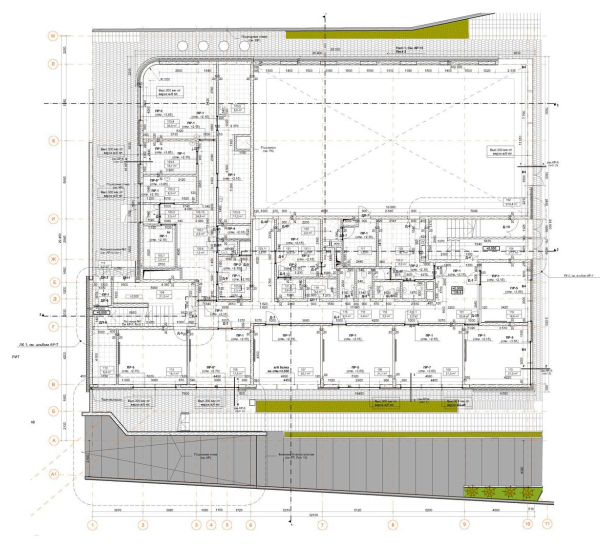 Plan of the 4th floor. The academic building of the “Cooperation School” on TagankaCopyright: © ASADOV Architects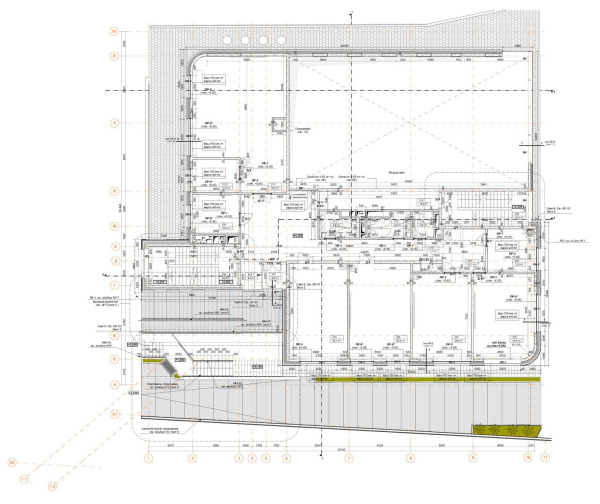 Plan of the 3rd floor. The academic building of the “Cooperation School” on TagankaCopyright: © ASADOV Architects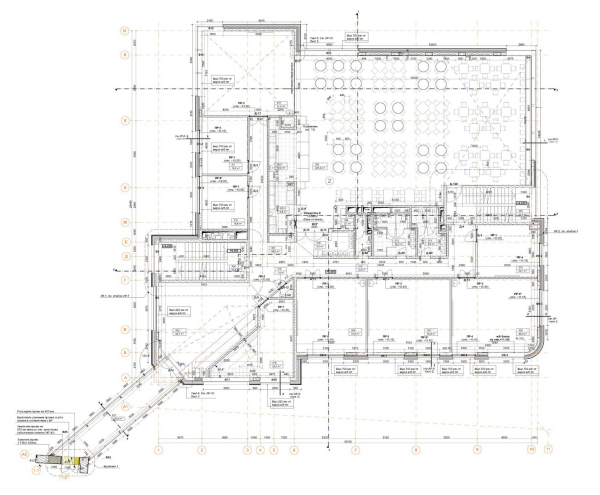 Plan of the 2nd floor. The academic building of the “Cooperation School” on TagankaCopyright: © ASADOV Architects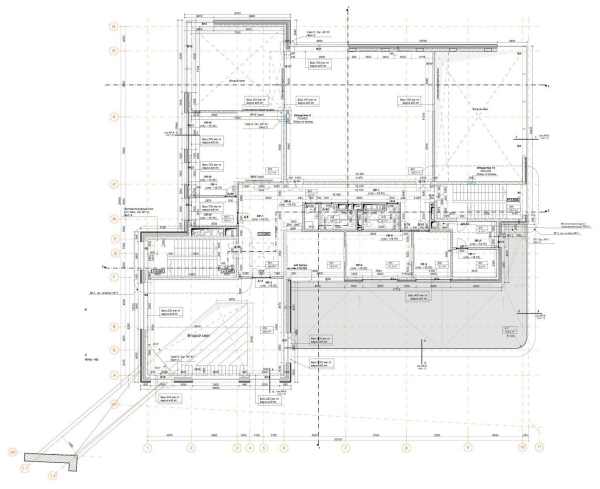 Plan of the 1st floor. The academic building of the “Cooperation School” on TagankaCopyright: © ASADOV Architects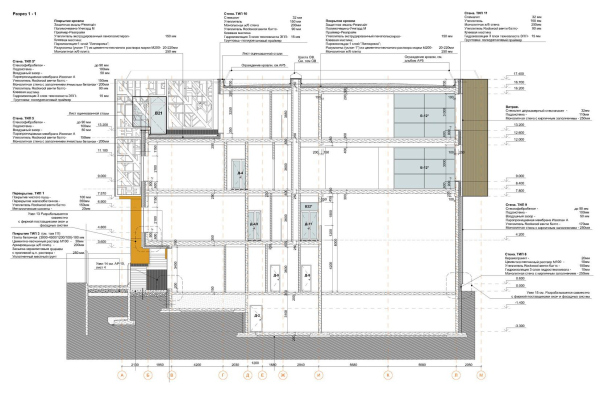 The cross-section view. The academic building of the “Cooperation School” on TagankaCopyright: © ASADOV Architects |
|

